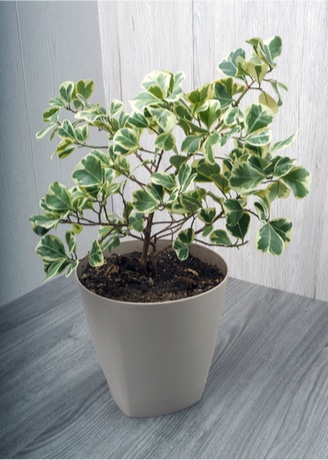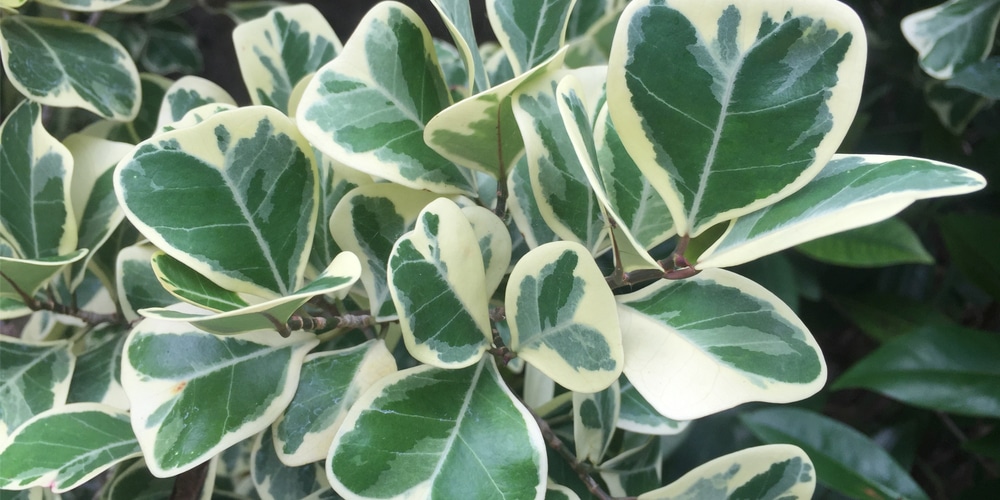Ficus Triangularis is a native of South Africa which gets its name due to its triangular-shaped foliage. These plants grow well indoors and are the perfect tropical plant for beginners. Ficus Triangularis are commonly called a Sweetheart Tree.
There are two types of Ficus Triangularis; the standard variety and a variegated version. These plants can be purchased from local nurseries and, as they are relatively rare, will likely cost more than most other houseplants. The variegated variety is particularly hard to find.
They have attractive glossy green leaves that are unique. Let’s look at how to grow and care for a Ficus Triangularis.
What is a Ficus Triangularis Plant?

The Ficus Triangularis is part of the Ficus genus and has fairly specific care requirements. It originates from tropical regions of central and South Africa and can grow up to 40 feet in the wild.
When kept as house plants, the Ficus Triangularis growth will be stunted, and these plants will likely grow up to 8 feet, depending on the size of the pot. These evergreen shrubs can spread up to 4-feet wide.
How to Care For a Ficus Triangularis Plant
Ficus Triangularis is a relatively easy plant to grow if you provide the correct conditions and care. These plants need to be pruned regularly to maintain their shape and size and require fertilization to get enough nutrients.
Ficus Triangularis can be planted outside in warmer areas with a USDA range of 12 to 13. In cooler areas, you can move your plant outdoors in the summer. If frost is expected in winter, you’ll need to move your plant indoors. Here are some tips to help you grow a thriving Ficus triangularis plant:
Sunlight
Ficus Triangularis (Sweetheart Tree) plants like to grow in sunlight that’s bright and indirect. You can grow your plant near a south or east-facing window. If you want to place your plant on the windowsill, you may need a light curtain to block the sun’s UV rays. Plants can get sunburned through glass, so it’s best to protect your plant from the scorching sun. Too much heat and light will cause your plant to fade, and it may even start dropping its leaves.
Watering Requirements
Ficus Triangularis can be watered using the ‘soak and dry method. You can give your plant a good watering and then leave it until the topsoil feels dry. It’s a wise idea to get into the habit of testing the soil before watering. Most people find that their plant needs to be watered once a week or every ten days, depending on the climate. In winter, watering can be reduced slightly.
Be careful not to overwater your Ficus Triangularis plant, as this will cause the leaves to drop. Your plant may also suffer from root rot if it’s left to sit in waterlogged soil. Ensure that your plant is growing in a pot with drainage holes to avoid root rot. Also, check that the holes don’t become blocked. You can add a layer of gravel or stones when repotting to help with drainage.
It’s best to use warm water or water at room temperature when watering a Ficus Triangularis. Water slowly and let any excess water drain away.
Soil
It’s best to grow a Ficus Triangularis plant in a good quality all-purpose potting pre mix. These plants need soil that’s loose and well-draining. You can also mix some perlite or vermiculite into the ground to help with drainage. Alternatively, add organic matter such as sphagnum peat moss, sand, and pine bark to add nutrients to the earth and help with aeration and drainage. Bottom of Form
Ficus Triangularis plants need neutral soil with a ph of about 7.0.
Temperature
Ficus Triangularis prefer to grow in temperatures of between 60°F to 75°F. They can cope if the temperature falls as low as 55°F, but shouldn’t be left outside in colder climates.
Sweetheart Trees are pretty sensitive and should be kept away from cold draughts. Don’t leave your plant near any open windows or beside the air conditioner. Ficus Triangularis don’t like sweltering temperatures and should also be kept away from the heater in winter.
Humidity
Ficus Triangularis are tropical plants that need to be grown in pretty humid conditions of around 60%. The humidity of an average home will be suitable for these plants. However, your plant will also benefit from being misted with a fine spray regularly. Be careful not to soak the leaves as this may cause a fungal infection.
Alternatively, you can use a water and pebble tray, group tropical plants together, or use a humidifier. Many people like to keep their Ficus Triangularis in the kitchen or bathroom as these rooms have higher moisture levels which is beneficial to the plant.
The Variegated Ficus Triangularis is more sensitive and prone to drying out of humidity isn’t high enough. Misting your plant daily in the mornings will stop the leaves from becoming dry and discolored. It’s best to mist tropical plants in the morning as this will reduce the chance of a fungal infection, as excess water will have all day to evaporate.
Fertilization
You can fertilize your Sweetheart Tree regularly throughout the growing season. It’s best to use a heavily diluted all-purpose fertilizer. Only apply fertilizer to wet soil as using on dry soil may cause root burn.
Ficus Triangularis don’t need to be fertilized in the fall or winter. Natural organic household plant fertilizers are best and can be used once a month; avoiding chemicals will help your plant stay healthy.
Pests
Ficus Triangularis can be affected by sap-sucking insects such as spider mites and mealybugs. TheThe insects can be removed by hand, showered off your plants, or killed with neem oil. Alternatively, use an insecticidal spray.
Conclusion
Ficus Triangularis (Sweetheart Tree) are unique plants that originate from tropical areas in Africa. They like warm weather, indirect sunlight, and relatively high humidity. These plants are easy to care for and can grow quite large. They should be watered and fertilized regularly and grown in well-draining soil.
